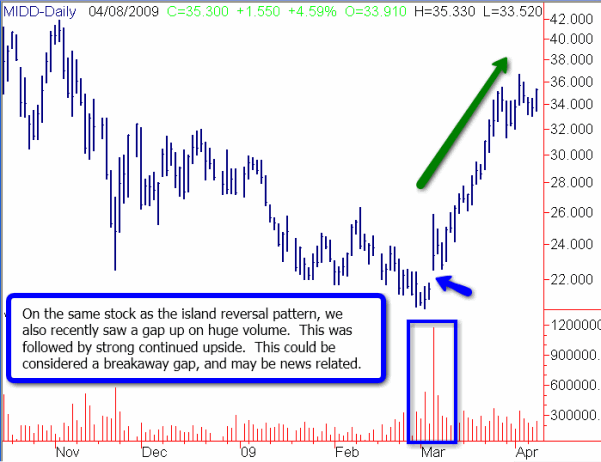| A Look At Gaps And Fills In Technical Analysis |
| By Price Headley |
Published
04/11/2009
|
Stocks
|
Unrated
|
|
|
|
A Look At Gaps And Fills In Technical Analysis
Let's take a look at gaps and fills, which are fairly well known technical indicators. A gap is exactly as it sounds, a gap between the data points of a stock's chart. Often the daily chart is useful for examining gaps, because there has to be some significant buying or selling pressure that causes a stock to move up or down sharply on the open on a particular day, then not "fill in" that gapped area during that trading day.
Gaps are often caused by external news events and also often are on heavy volume. The chart below shows a big gap down in Wal-Mart (WMT) in January, which was on huge volume. The bearish gap was followed by further short-term downside. The shares have still not completely filled in this gap area, although recently they are attempting to. The gap area is now potential resistance to further upside on this chart.

On the chart of Caterpillar (CAT) below, you can see the shares had a bullish up side gap, but when that gap was filled in on the downside about a month later, it preceded a sharp leg down in the stock. Filling in of gaps often nullifies and sometimes reverses the "power" that a gap has to determine direction.

The following Mosaic (MOS) chart shows a bearish gap on heavy volume. The gap down was followed by further downside. Since then, the shares have been unable to overtake the lower gap area, which is now acting as resistance.

The following chart of Middleby (MIDD) shows a gap up that created what is called an "island". The stock consolidated above the gap zone into an island, then breached the gap zone. Subsequently, the shares declined heavily. This is often called an "island reversal".

The next chart, also of MIDD, shows a recent gap up on heavy volume. This was followed by continued strong upside in the shares. This could be considered a "breakaway gap".

Gaps, fills, and islands are usual parts of technical analysis. Significant gaps up and down are often important signposts in a stock's chart. Whether a gap is filled in quickly or at all is significant as well. Especially on the Daily Charts, keep an eye peeled for gaps and the subsequent action in the stock.
Price Headley is the founder and chief analyst of BigTrends.com.
|